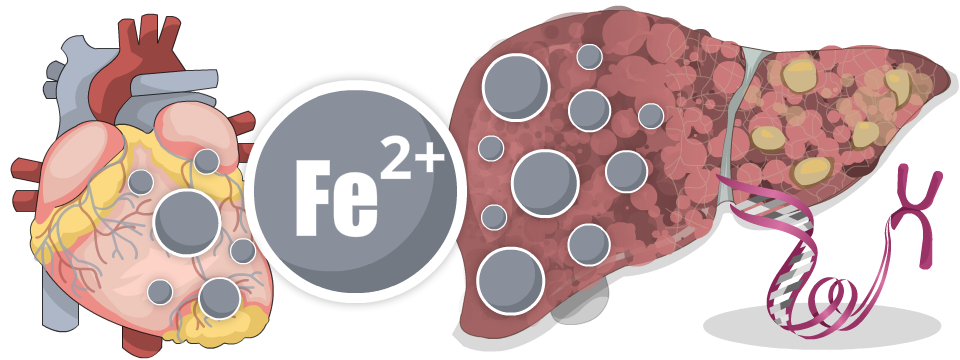Hemochromatosis is an inherited disease that causes the body to absorb too much iron. It’s one of the most common genetic diseases in Canada, affecting about 1 in 300. Normally, people absorb only enough iron to meet the body’s daily requirements. The remainder is usually excreted through the bowels. But with hemochromatosis, the body keeps absorbing iron and storing it in different organs and tissues long after its needs are met.
Your liver is the first organ to store iron. When its storage capacity is exhausted, iron continues to build up in the heart, the skin, the pancreas, the pituitary gland, and elsewhere in the body. If left untreated, it can create damage in the liver, which may lead to liver failure and liver cancer. Likewise, damage to the heart can result in heart failure or sudden death, and damage to the pancreas may lead to diabetes.
Causes
Hemochromatosis is hereditary. To have the disease, a patient must have inherited two defective genes, one from each parent. Siblings of an affected person have a 25% chance of getting this disease. Children of a parent with hemochromatosis are less likely to be affected, since the other parent must be also be a carrier of the defective gene.

Symptoms
In people with hemochromatosis, the liver begins to retain iron at birth, but it may take 20 to 30 years before symptoms begin to appear. In the early stages of hemochromatosis, there may be no signs. But when symptoms show, they include:
- arthritis (swelling in the joints, particularly in the knees and the knuckles of the middle and index fingers)
- fatigue
In the later stages of the disease, symptoms include:
- abdominal pain or tenderness
- ascites (enlarged abdomen from fluid buildup)
- bronze or grey-coloured skin
- diabetes
- heart failure
- jaundice (yellowing of the skin and eyes)
- bleeding varices (enlarged veins in the esophagus)
Diagnosis
Doctors use blood tests to detect hemochromatosis. They measure iron levels in the blood and the total amount of iron deposited in the tissues. The most common tests are for transferrin saturation and serum ferritin.
A genetic test is the most common test used to diagnose hemochromatosis. This requires a blood sample, which is analyzed by a lab that specializes in DNA testing. This genetic test has eliminated the need for a liver biopsy in many patients with hemochromatosis.
But sometimes it’s necessary for your doctor to order a liver biopsy to see the extent of liver damage and check the amount of iron stored there.
If someone is diagnosed with hemochromatosis, their siblings and children over the age of 18 should be checked. Screening is most important for siblings, since they have a 25% chance of inheriting both the defective genes from their parents.
Genetic screening has allowed for diagnosis at birth, before iron overload sets in. But testing for hemochromatosis within families usually starts in the teen years rather than with children or infants.
Treatment
The first goal of treatment is to reduce the amount of iron stored in your body. This is usually done by a process called venesection or phlebotomy (blood letting) on a weekly basis. It’s a lot like donating blood.
Red blood cells contain iron. When you undergo phlebotomy, you lose red blood cells and excess iron (caused by hemochromatosis). This treatment can take months or even two or three years depending on the amount of excess iron in your body.
You must continue to have your iron levels monitored regularly, even after the phlebotomy treatment has removed the excess iron. Phlebotomy may be reduced to a less frequent “maintenance” level, for example four times a year.
Generally, phlebotomy treatment isn’t used for patients with cirrhosis and low hemoglobin levels.
Injury to the liver from hemochromatosis is reversible if you start treatment before cirrhosis develops. However, there is an increased risk of liver cancer in hemochromatosis patients who have cirrhosis.
Q&A

No. However, you shouldn’t use iron supplements, multi-vitamins, or mineral preparations containing iron.
You should also avoid vitamin C, which enhances iron absorption when consumed with food. Or, you should only take vitamin C four hours before or after a meal.
Alcohol enhances iron absorption, which is one reason you should avoid it or consume it only in moderate amounts. Another reason is that it can cause additional liver damage beyond that caused by hemochromatosis.
References:
The information on this page was adapted (with permission) from the references below, by the Cirrhosis Care Alberta project team (physicians, nurse practitioners, registered nurses, registered dietitians, physiotherapists, pharmacists, and patient advisors).
This information is not intended to replace advice from your healthcare team. They know your medical situation best. Always follow your healthcare team’s advice.
References:
